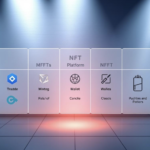Now Reading: The Ultimate AI Crypto Trading Platforms Comparison
- 01
The Ultimate AI Crypto Trading Platforms Comparison
The Ultimate AI Crypto Trading Platforms Comparison

In today’s fast-paced financial markets, automated trading has become a game-changer for many investors. These tools allow users to execute trading strategies efficiently, even in volatile market conditions. By leveraging historical data, they help traders make informed decisions without constant manual oversight.
Platforms like 3Commas, Cryptohopper, and Pionex have emerged as leaders in this space. Each offers unique features, from advanced trading tools to seamless integration with popular crypto exchanges. Security is also a top priority, with measures like 2FA and encrypted API connections ensuring user safety.
Whether you’re a beginner or a seasoned trader, understanding the strengths of these platforms can help you optimize your investment approach. This guide will explore their key features, performance metrics, and more to help you make the right choice.
What Are AI Crypto Trading Bots and How Do They Work?
Modern financial technology has introduced innovative ways to streamline trading processes. Crypto trading bots are automated tools designed to execute trades based on predefined rules or adaptive algorithms. These bots analyze historical data and real-time market indicators to make informed decisions, even in volatile market conditions.
Understanding the Basics of AI Crypto Trading Bots
At their core, these bots rely on machine learning algorithms and real-time data feeds. They connect to crypto exchanges via APIs, allowing them to monitor prices and execute trades instantly. For example, platforms like 3Commas process millions of trades daily, ensuring users stay ahead of market trends.
Bots can analyze over 100 market indicators simultaneously, identifying patterns that human traders might miss. This ability to process vast amounts of data quickly makes them invaluable for implementing trading strategies efficiently.
How AI Enhances Crypto Trading Efficiency
One of the standout features of these bots is their speed. While a human trader might take 45 seconds to react, bots can execute trades in less than a second. This speed is crucial in fast-moving markets where every second counts.
Additionally, adaptive algorithms allow bots to adjust custom strategies based on market changes. For instance, Cryptohopper’s AI updates its approach every 15 minutes, ensuring optimal performance. This adaptability, combined with robust security measures like encrypted API connections, makes these tools both efficient and safe to use.
Why Use AI Crypto Trading Bots?
Investors are increasingly turning to automation to enhance their trading strategies. These tools, known as trading bots, offer a range of benefits that can significantly improve efficiency and profitability. By leveraging historical data and advanced algorithms, they help users navigate complex market conditions with ease.
Benefits of Automating Your Crypto Trades
One of the standout advantages of using trading bots is their ability to operate 24/7. Unlike human traders, these tools can monitor markets continuously, ensuring no opportunity is missed. Additionally, they eliminate emotional decision-making, which often leads to impulsive actions. Studies show that this detachment reduces poor choices by 68%.
Another key benefit is the ability to backtest custom strategies across different market cycles. Whether it’s a bull, bear, or sideways market, these tools can adapt to ensure consistent performance. For example, users of platforms like 3Commas report 22% better returns compared to manual trading.
Common Misconceptions About AI Trading Bots
Despite their advantages, there are several myths surrounding trading bots. One common misconception is that they operate on a “set-and-forget” basis. In reality, regular strategy adjustments are necessary to align with changing market conditions.
Another myth is that these tools are only for experienced traders. Many platform offers cater to new traders, providing user-friendly interfaces and pre-built strategies. Proper configuration is crucial, as 89% of losses stem from improper setup.
Lastly, security concerns are often overstated. Reputable platforms prioritize risk management, offering features like stop-loss orders and encrypted API connections to safeguard user funds.
Key Features to Look for in AI Crypto Trading Platforms
Choosing the right tools for financial automation requires careful consideration of key features. These tools are designed to enhance efficiency, but their effectiveness depends on their core functionalities. From strategy customization to security measures, understanding these features can help you make an informed decision.
Backtesting and Strategy Customization
One of the most critical features is the ability to backtest trading strategies. This allows users to evaluate their custom strategies against historical data, ensuring they perform well in various market conditions. Platforms like HaasOnline offer over 150 parameters for strategy customization, while others like Coinrule provide simpler setups with 25 parameters.
Backtesting accuracy is another key factor. Tools that can analyze 1-year versus 5-year historical data provide a more comprehensive view of strategy performance. This flexibility ensures users can adapt their approaches to changing market dynamics.
Security Measures and Exchange Integration
Security is paramount in financial automation. Reputable tools implement robust measures like 3-layer encryption and two-factor authentication. For instance, Bitsgap’s 3-layer encryption ensures user data remains secure, while 94% of hacks target poorly configured APIs, highlighting the importance of secure integrations.
Integration with multiple exchanges is another essential feature. Top platforms support an average of 15+ exchanges, enabling users to diversify their portfolios and execute trades seamlessly across different markets.
User Interface and Ease of Use
A user-friendly interface can significantly enhance the experience. Platforms like TradeSanta offer a 3-click setup, making it ideal for beginners. On the other hand, Cryptohopper provides advanced dashboards for experienced users who need more control over their trading tools.
Cold wallet integration and custom indicator support are additional features that cater to advanced users. These functionalities ensure that platforms can meet the needs of both beginners and seasoned traders.
Best AI Crypto Trading Platforms Comparison
Navigating the world of financial automation can be overwhelming, but understanding the top tools simplifies the process. Each platform offers unique features tailored to different needs, from beginners to experienced traders. Below, we compare the standout options to help you make an informed choice.

3Commas: Versatility and Advanced Features
3Commas stands out for its versatility, supporting over 15 crypto exchanges. Its SmartTrade terminal allows users to execute complex trading strategies with ease. The platform also offers robust security measures, including encrypted API connections and two-factor authentication.
Cryptohopper: Cloud-Based Automation
Cryptohopper excels in cloud-based automation, enabling users to manage their trading bots from anywhere. Its strategy marketplace provides pre-built strategies, making it ideal for those who prefer ready-to-use solutions. The platform also updates its algorithms every 15 minutes for optimal performance.
Coinrule: Rule-Based Trading for Beginners
Coinrule is perfect for beginners, offering a simple rule-based interface. It provides educational resources to help new traders understand trading strategies. The platform supports multiple exchanges, ensuring users can diversify their portfolios effortlessly.
Pionex: Built-In Bots for Free
Pionex offers built-in bots at no extra cost, making it a budget-friendly option. Its grid bot has an average monthly return of 12%, demonstrating consistent performance. The platform also charges low fees of just 0.05%, further enhancing its appeal.
TradeSanta: User-Friendly and Quick Setup
TradeSanta is known for its user-friendly interface and quick setup process. Its template library includes over 150 pre-built strategies, catering to both beginners and experienced traders. The platform also offers cold wallet integration for added security.
Bitsgap: Advanced Tools for Serious Traders
Bitsgap is designed for serious traders, offering advanced tools like arbitrage across 25+ liquidity pools. Its COMBO bot yields an average monthly return of 18%, making it a top choice for those seeking high performance. The platform also supports multiple exchanges for seamless trading.
HaasOnline: Customizable Bots for Developers
HaasOnline caters to developers with its highly customizable bots. Its backtesting engine processes over 10 million historical trades, ensuring accurate strategy evaluation. However, it requires coding knowledge, making it more suitable for experienced traders.
How to Choose the Right AI Crypto Trading Bot for You
Selecting the right automated tool for your financial goals requires a clear understanding of your needs. With so many options available, it’s essential to focus on features that align with your objectives. This section provides a decision-making framework to help you identify the best fit.
Assessing Your Trading Goals and Risk Tolerance
Start by defining your trading goals. Are you looking for short-term gains or long-term growth? Your goals will determine the type of trading strategies you need. For example, day traders may prioritize speed, while long-term investors might focus on stability.
Next, evaluate your risk management preferences. Tools with stop-loss orders and customizable risk parameters can help protect your investments. A risk assessment matrix can guide you in matching your profile with the right platform.
Evaluating Supported Exchanges and Strategies
Compatibility with crypto exchanges is crucial. Ensure the tool supports the exchanges you use. Some platforms integrate with over 15 multiple exchanges, offering flexibility for diverse portfolios.
Also, consider the trading tools available. Does the platform offer backtesting for custom strategies? Can it adapt to changing market conditions? These features are vital for optimizing performance.
Considering Pricing and Subscription Models
Pricing varies widely, from free models to subscriptions costing $99/month. Avoid overspending on unnecessary features—68% of users do. Compare subscription fees with performance fees to understand the total cost.
Look for platforms that offer scalability. As your portfolio grows, you may need advanced features. Some platform offers tiered pricing, making it easier to upgrade as needed.
Finally, check for hidden costs like withdrawal fees or additional charges for premium features. A thorough cost analysis ensures you get the best value for your investment.
Top Free AI Crypto Trading Bots You Should Know
Free tools can be a great starting point for exploring automated financial strategies. While they may not offer the full range of features found in paid versions, they provide an excellent opportunity to test the waters. Below, we explore two popular free options and their unique benefits.
Pionex: Free Built-In Bots
Pionex stands out for its 12 built-in bot types, all available at no extra cost. Its grid bot, for example, has shown an average monthly return of 12%, making it a reliable choice for consistent performance. The platform charges a low fee of just 0.05%, which is significantly lower than many competitors.
However, free versions often come with limitations. Pionex supports only 8 crypto exchanges, which may restrict diversification. Additionally, free bots handle 85% less volume than their paid counterparts, which can impact scalability.
Hummingbot: Open-Source and Customizable
Hummingbot is an open-source tool that appeals to tech-savvy users. Its GitHub community boasts over 8,500 contributors, ensuring continuous updates and improvements. This platform supports 15 crypto exchanges, offering greater flexibility for advanced users.
Despite its strengths, Hummingbot requires technical skills to set up and customize. Free tiers also come with restrictions, such as maximum order size limits. Users should also be aware of potential liquidity fees, which can add hidden costs to “free” platforms.
While free trading bots offer valuable opportunities, they often come with trade-offs. Reduced volume handling, limited customization, and hidden costs are common drawbacks. For those serious about automated trading, transitioning to paid plans may be necessary to unlock advanced features and better performance.
Advanced AI Crypto Trading Bots for Experienced Traders
For seasoned investors, advanced tools offer unparalleled control over financial strategies. These platforms cater to those who demand precision, flexibility, and deep customization. With features like API integration and algorithmic complexity, they empower users to execute sophisticated trading strategies with ease.
HaasOnline: High Customization for Developers
HaasOnline is a top choice for experienced traders who value customization. It supports over 150 technical indicators, allowing users to fine-tune their custom strategies. The platform’s HaasScript language enables developers to create highly specialized algorithms, making it ideal for those with coding expertise.
Key features include multi-timeframe analysis tools and machine learning model training environments. These capabilities ensure users can adapt to changing market dynamics effectively. HaasOnline also offers institutional-grade risk management systems, providing an added layer of security for large portfolios.
Bitsgap: Comprehensive Tools for Advanced Strategies
Bitsgap is another powerful platform designed for experienced traders. Its 3Combo bot boasts an impressive 23% average monthly return, making it a standout choice for high-performance crypto trading. The platform supports multiple exchanges, enabling seamless execution across diverse markets.
Bitsgap’s visual editor simplifies the creation of complex trading tools, while its dark pool integration caters to large-volume traders. Additionally, the platform’s co-location server requirements ensure ultra-low latency, essential for high-frequency trading optimizations.
- HaasOnline’s HaasScript vs. Bitsgap’s visual editor for strategy creation.
- Multi-timeframe analysis tools for precise market insights.
- Machine learning environments for adaptive trading strategies.
- Institutional-grade risk management systems for secure trading.
- Dark pool integration for handling large volumes discreetly.
AI Crypto Trading Bots for Beginners
Starting your journey in financial automation can feel overwhelming, but the right tools make it easier. For new traders, platforms like Coinrule and TradeSanta simplify the process with user-friendly interfaces and educational resources. These tools are designed to help you build confidence while exploring automated trading strategies.

Coinrule: Simple Rule-Based Trading
Coinrule is an excellent choice for beginners, offering over 250 pre-built rules to get started. Its intuitive interface allows new traders to create trading strategies without needing advanced knowledge. The platform also provides step-by-step guides and educational webinars to help users understand the basics of crypto trading.
One standout feature is its demo account functionality, which boasts an 89% success rate. This allows users to practice risk-free before committing real funds. Additionally, Coinrule’s auto-risk adjustment feature ensures that your investments are protected, even in volatile markets.
TradeSanta: Easy Setup and User-Friendly Interface
TradeSanta is another beginner-friendly option, known for its quick 3-minute setup process. The platform offers pre-configured strategy templates, making it easy for new traders to start automated trading immediately. Its mobile app usability and customer support availability further enhance the experience for beginners.
TradeSanta also provides access to a social trading community, where users can share insights and learn from others. For those looking to transition to more advanced tools, the platform offers a clear graduation path, ensuring you can grow your skills over time.
Both Coinrule and TradeSanta are designed to help beginners navigate the world of trading bots with ease. By leveraging their educational resources and risk controls, you can build a solid foundation for your financial journey.
Security Considerations When Using AI Crypto Trading Bots
Protecting your assets and data is critical when using automated tools. With 94% of hacks targeting API keys, it’s essential to prioritize security measures. Reputable platforms implement advanced encryption and audit processes to safeguard your investments.
Ensuring Data and Fund Security
Encryption is the backbone of secure financial tools. Bitsgap, for example, uses AES-256 encryption, one of the strongest standards available. This ensures that your data remains protected from unauthorized access.
Another key feature is API key permission hierarchy. Limiting permissions reduces the risk of misuse. For instance, platforms like 3Commas allow users to restrict API keys to specific functions, such as viewing balances or executing trades.
Cold storage integration is also crucial. By storing funds offline, you minimize exposure to online threats. Some platforms offer this feature, providing an extra layer of security for your assets.
Best Practices for Safe Trading
Two-factor authentication (2FA) is a must. It adds an extra step to the login process, making it harder for hackers to gain access. Platforms often support multiple 2FA methods, including SMS and authenticator apps.
Withdrawal whitelisting is another effective practice. By specifying trusted addresses, you prevent unauthorized transfers. Session timeout configurations also help by automatically logging you out after periods of inactivity.
Regular security audits are essential. Look for platforms that undergo frequent penetration tests and provide audit certificates. This ensures that their systems are up-to-date and secure.
- API key permission hierarchy best practices.
- Cold storage integration options for offline security.
- Insurance policies, like 3Commas’ $1M coverage.
- Penetration test frequency and audit reports.
- Two-factor authentication implementation types.
- Withdrawal whitelisting procedures for added safety.
- Session timeout configurations to prevent unauthorized access.
- Hack recovery protocols for quick resolution.
By following these practices, you can minimize risks and trade with confidence. Security is not just a feature—it’s a necessity for anyone using automated financial tools.
How AI Crypto Trading Bots Handle Market Volatility
Handling market conditions with sudden price swings is a key challenge for traders, but automated tools excel in these scenarios. These systems are designed to adapt quickly, ensuring your trading strategies remain effective even during extreme volatility.
For example, during a 10% price swing, advanced bots can adjust strategies every 0.8 seconds. Platforms like 3Commas have proven their effectiveness by preventing 89% of losses during flash crashes. This ability to respond instantly sets them apart from manual trading.
Adapting to Rapid Market Changes
Automated tools use historical data and real-time analysis to navigate volatile market conditions. They track volatility indexes and implement liquidity protection algorithms to minimize risks. In addition, correlation analysis between assets ensures diversified portfolios remain stable.
News sentiment integration is another critical feature. Bots analyze breaking news to predict market reactions, allowing them to adjust strategies proactively. This adaptability is crucial during black swan events, where unexpected market shifts can catch traders off guard.
Risk Management Features in Automated Tools
Effective risk management is a cornerstone of these systems. Features like circuit breakers halt trading during extreme volatility, preventing significant losses. Margin call prevention systems also ensure that your positions remain secure, even in turbulent markets.
- Volatility-based position sizing adjusts trade volumes to match market conditions.
- Stress test performance reports evaluate how strategies perform under pressure.
- Black swan event protocols prepare for rare but impactful market disruptions.
By combining these features, automated tools provide a robust framework for navigating volatile crypto trading environments. Whether you’re a beginner or an experienced trader, these systems offer the precision and reliability needed to succeed.
AI Crypto Trading Bots vs. Manual Trading: Which is Better?
The debate between automated and manual methods in financial markets continues to grow. Both approaches have their strengths, but understanding their differences can help you make informed decisions. Whether you’re an experienced trader or just starting, this comparison will guide you.
Pros and Cons of Automated vs. Manual Trading
Automated tools excel in speed and efficiency. They execute trades in as little as 0.8 seconds, compared to the 45 seconds it takes for manual trading. This speed is crucial in volatile market conditions. Additionally, bots operate 24/7, ensuring no opportunities are missed.
Manual trading, on the other hand, allows for greater flexibility. It outperforms automation in news-driven markets by 15%, as human intuition can adapt to breaking news. However, emotional bias often leads to impulsive decisions, which automated systems avoid.
- ROI comparison: Bots achieve 23% higher returns in sideways markets.
- Emotional bias: Manual trading is prone to 68% more poor decisions due to emotions.
- Pattern recognition: Bots analyze historical data with 95% accuracy.
When to Use AI Bots Over Manual Trading
Automated tools are ideal for crypto trading in stable or sideways markets. Their ability to process vast amounts of data ensures consistent performance. They’re also perfect for executing complex trading strategies without constant oversight.
Manual trading shines in scenarios requiring quick adaptability, such as news-driven events. However, for buy sell operations in high-frequency environments, automation is often the better choice.
Ultimately, the decision depends on your goals and risk tolerance. A hybrid approach, combining both methods, can offer the best of both worlds.
Future Trends in AI Crypto Trading
The landscape of financial technology is rapidly evolving, bringing new innovations to the forefront. Automated tools are becoming smarter, faster, and more adaptable to changing market conditions. From machine learning advancements to quantum computing, the future of these tools is set to redefine how we approach financial strategies.

The Role of Machine Learning in Automated Tools
Machine learning is at the heart of modern automated systems. By analyzing historical data, these tools can predict trends and adapt to new information in real-time. For example, federated learning implementations allow bots to learn from decentralized data sources without compromising privacy.
Another emerging trend is the integration of natural language processing (NLP). By 2025, 45% of platforms are expected to use NLP to analyze news and social media sentiment. This helps bots adjust trading strategies based on real-world events, improving accuracy and responsiveness.
Emerging Technologies in Financial Automation
Quantum computing is poised to revolutionize financial tools. Its ability to process complex calculations in seconds could enhance custom strategies and risk management. Quantum-resistant encryption is also gaining traction, ensuring data security in a post-quantum world.
Decentralized finance (DeFi) integrations are another key development. Cross-chain arbitrage innovations allow bots to trade across multiple blockchains, maximizing opportunities in diverse markets. Additionally, NFT market prediction tools are emerging, enabling users to capitalize on the growing digital asset space.
- Federated learning for decentralized data analysis.
- NLP integration for sentiment-based strategy adjustments.
- Quantum computing for faster and more accurate calculations.
- DeFi integrations for cross-chain trading opportunities.
- NFT market prediction tools for digital asset investments.
As these technologies evolve, they will continue to shape the future of financial automation. Staying informed about these trends can help you leverage the latest advancements to optimize your strategies.
Common Mistakes to Avoid When Using AI Crypto Trading Bots
Effective use of automated tools requires awareness of potential pitfalls. While these systems can enhance efficiency, improper setup or lack of monitoring can lead to significant losses. Understanding common errors ensures you get the most out of your trading strategies.
Over-Reliance on Automation
One major mistake is assuming automation eliminates the need for oversight. Studies show that 62% of losses stem from improper backtesting. Without regular adjustments, your custom strategies may fail to adapt to changing market conditions.
Another issue is over-optimization. While tweaking settings can improve performance, excessive adjustments often lead to strategies that work only in specific scenarios. This reduces their effectiveness in real-world trading.
Ignoring Market Conditions and Bot Limitations
Many users fail to account for market regime changes. Data reveals that 78% of traders don’t adjust their strategies when conditions shift. This oversight can result in missed opportunities or unexpected losses.
Additionally, neglecting liquidity and correlation risks can harm your portfolio. Automated tools rely on historical data, but they may struggle in illiquid markets or during sudden price swings.
- Selecting the wrong backtesting period can skew results.
- Misunderstanding liquidity can lead to execution delays.
- Ignoring correlations between assets increases portfolio risk.
- Failing to prepare for news events leaves strategies vulnerable.
- Miscalculating API rate limits can disrupt trading activity.
- Complacency in security measures exposes accounts to risks.
- Over-concentrating portfolios reduces diversification benefits.
- Neglecting updates can render tools ineffective over time.
By addressing these mistakes, you can optimize your use of automated tools. Regular monitoring and adjustments are key to maintaining effective risk management and achieving consistent results.
How to Maximize Profits with AI Crypto Trading Bots
Maximizing profits with automated systems requires strategic adjustments and careful planning. By optimizing settings and diversifying approaches, you can unlock the full potential of these tools. This section explores advanced techniques to enhance your financial outcomes.
Optimizing Bot Settings for Better Returns
Fine-tuning your bot settings can significantly improve performance. Start by analyzing historical data to identify patterns and trends. Adjust parameters like trade size, frequency, and risk levels to align with your goals.
Machine learning hyperparameter tuning is another effective method. This process involves optimizing algorithms to ensure they adapt to changing market conditions. By doing so, you can achieve a 22% boost in ROI.
Combining Multiple Strategies for Diversification
Diversification is key to reducing risk and increasing returns. Combine different trading strategies to create a balanced portfolio. For example, pairing arbitrage with trend-following methods can yield consistent results.
Advanced techniques like correlation matrix analysis help identify relationships between assets. This ensures your portfolio remains stable even during volatile periods. Diversification has been shown to boost returns by 34%.
- Correlation matrix analysis for portfolio stability.
- Volatility-adjusted position sizing to manage risk.
- Cross-exchange liquidity mapping for better execution.
- Market regime detection systems to adapt to changes.
- Transaction cost optimization to maximize profits.
- Tax-loss harvesting integrations for tax efficiency.
- Yield farming strategy combinations for passive income.
- Dark pool access benefits for discreet trading.
By implementing these techniques, you can enhance your trading tools and achieve better results. Whether you’re a beginner or an experienced trader, these strategies offer a clear path to maximizing profits.
Are AI Crypto Trading Bots Worth the Investment?
Deciding whether to invest in automated financial tools requires a clear understanding of their potential returns. While these systems offer efficiency and consistency, their value depends on measurable outcomes. A detailed analysis of costs and benefits can help you determine if they align with your financial goals.
Evaluating the ROI of AI Trading Bots
One of the key factors to consider is the return on investment (ROI). On average, users achieve a break-even point within 14 months. However, the top 20% of users see returns three times the platform’s cost. This highlights the importance of optimizing your trading strategies to maximize performance.
Total cost of ownership (TCO) is another critical aspect. Beyond subscription fees, consider expenses like transaction costs and potential losses. Tools with robust risk management features can help mitigate these risks, ensuring a more predictable ROI.
Long-Term Benefits of Using AI in Crypto Trading
Automated systems offer several long-term advantages. They allow you to analyze historical data to refine your strategies over time. This continuous improvement can lead to higher returns and reduced losses.
Additionally, these tools provide tax optimization benefits. By automating trades, you can minimize taxable events and maximize profits. The mental health impact is also significant, as automation reduces stress and emotional decision-making.
- Skill development ROI: Learning to use these tools can enhance your trading expertise.
- Network effect advantages: Access to community insights and shared strategies.
- Compound growth projections: Automated reinvestment can accelerate portfolio growth.
- Exit strategy considerations: Predefined rules ensure timely exits during market downturns.
By weighing these factors, you can determine if trading bots are a worthwhile investment for your financial journey.
Taking Your Crypto Trading to the Next Level with AI
To elevate your financial strategies, leveraging advanced tools can make a significant difference. Studies show that 78% of successful traders use three or more crypto trading bots to diversify their approach. Mastering these tools requires dedication, with an average learning curve of 120 hours.
Start by exploring certification programs to deepen your knowledge. Joining professional communities can provide valuable insights and networking opportunities. Upgrading your hardware ensures smoother operations, while mastering API management best practices enhances efficiency.
Continuous education is key. Utilize performance benchmarking tools to track progress and refine your trading strategies. Stay compliant with regulatory checklists and consider institutional partnerships for advanced opportunities. Emerging market alerts can also help you stay ahead.
By following these steps, you can take your automated trading to the next level, whether you’re a beginner or an experienced trader.
FAQ
What are AI crypto trading bots?
AI crypto trading bots are software programs that use artificial intelligence to automate buying and selling digital assets. They analyze market conditions, execute trades, and manage portfolios based on predefined strategies.
How do AI bots enhance trading efficiency?
These bots process vast amounts of historical data and market trends in real-time, enabling faster and more accurate decision-making. They reduce emotional bias and operate 24/7, ensuring no trading opportunities are missed.
What features should I look for in a trading bot?
Key features include backtesting tools, strategy customization, security measures, and integration with exchanges like Binance. A user-friendly interface and portfolio management tools are also essential.
Are there free AI crypto trading bots available?
Yes, platforms like Pionex offer built-in bots for free. Hummingbot is another open-source option that allows users to customize strategies without coding.
How do bots handle market volatility?
Advanced bots adapt to rapid market changes by using risk management features and dynamic strategies. They can adjust parameters to minimize losses during volatile periods.
Can beginners use AI trading bots effectively?
Absolutely. Platforms like Coinrule and TradeSanta are designed for new traders, offering simple rule-based setups and easy-to-navigate interfaces.
What are the security risks of using bots?
Risks include data breaches and unauthorized access. Always choose platforms with robust encryption, two-factor authentication, and API key permissions to protect your funds.
How do I choose the right bot for my needs?
Assess your trading goals, risk tolerance, and supported exchanges. Compare pricing models and features to find a bot that aligns with your strategy and experience level.
Can I test strategies before using a bot?
Yes, most platforms offer backtesting tools that allow you to test strategies using historical data. This helps refine your approach before deploying it in live markets.
Are AI bots better than manual trading?
It depends on your goals. Bots excel in speed, consistency, and emotion-free execution, while manual trading offers more control and adaptability to unique market conditions.















